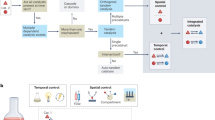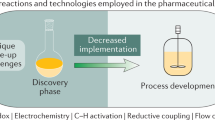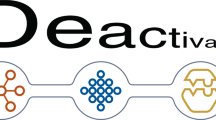Abstract
Tandem catalysis is a growing field that is beginning to yield important scientific and technological advances toward new and more efficient catalytic processes. 'One-pot' tandem reactions, where multiple catalysts and reagents, combined in a single reaction vessel undergo a sequence of precisely staged catalytic steps, are highly attractive from the standpoint of reducing both waste and time. Orthogonal tandem catalysis is a subset of one-pot reactions in which more than one catalyst is used to promote two or more mechanistically distinct reaction steps. This Perspective summarizes and analyses some of the recent developments and successes in orthogonal tandem catalysis, with particular focus on recent strategies to address catalyst incompatibility. We also highlight the concept of thermodynamic leveraging by coupling multiple catalyst cycles to effect challenging transformations not observed in single-step processes, and to encourage application of this technique to energetically unfavourable or demanding reactions.
This is a preview of subscription content, access via your institution
Access options
Subscribe to this journal
Receive 12 print issues and online access
$259.00 per year
only $21.58 per issue
Buy this article
- Purchase on Springer Link
- Instant access to full article PDF
Prices may be subject to local taxes which are calculated during checkout



Similar content being viewed by others
Change history
01 June 2015
In the version of this Perspective originally published, Figure 2a should have depicted the conversion of CO2 to formic acid and on to a formate ester. This error has now been corrected in all online versions.
23 June 2015
Nature Chemistry 7, 477–482 (2015); published online 20 May 2015; corrected after print 1 June 2015. In the version of this Perspective originally published, Figure 2a should have depicted the conversion of CO2 to formic acid and on to a formate ester. The corrected reaction pathway is shown below. This error has now been corrected in all online versions.
References
Climent, M. J., Corma, A, Iborra, S. & Sabater, M. J. Heterogeneous catalysis for tandem reactions. ACS Catal. 4, 870–891 (2014).
Mata, J. A., Hahn, F. E. & Peris, E. Heterometallic complexes, tandem catalysis and catalytic cooperativity. Chem. Sci. 5, 1723–1732 (2014).
Robert, C. & Thomas, C. M. Tandem catalysis: a new approach to polymers. Chem. Soc. Rev. 42, 9392–9402 (2013).
Oroz-Guinea, I. & Garcia-Junceda, E. Enzyme catalysed tandem reactions. Curr. Opin. Chem. Biol. 17, 236–249 (2013).
Climent, M. J., Corma, A. & Iborra, S. Homogeneous and heterogeneous catalysts for multicomponent reactions. R. Soc. Chem. Adv. 2, 16–58 (2012).
Zhou, J. Recent advances in multicatalyst promoted asymmetric tandem reactions. Chem. Asian J. 5, 422–434 (2010).
Atesin, A. C., Ray, N. A., Stair, P. C. & Marks, T. J. Etheric C–O bond hydrogenolysis using a tandem lanthanide triflate/supported palladium nanoparticle catalyst system. J. Am. Chem. Soc. 134, 14682–14685 (2012).
Li, Z., Assary, R. S., Atesin, A. C., Curtiss, L. A. & Marks, T. J. Rapid ether and alcohol C–O bond hydrogenolysis catalyzed by tandem high-valent metal triflate plus supported Pd catalysts. J. Am. Chem. Soc. 136, 104–107 (2014).
Wang, X. & Rinaldi, R. A route for lignin and bio-oil conversion: dehydroxylation of phenols into arenes by catalytic tandem reactions. Angew. Chem. Int. Ed. 52, 11499–11503 (2013).
Barber, D. M., Ďuriš, A., Thompson, A. L., Sanganee, H. J. & Dixon, D. J. One-pot asymmetric nitro-mannich/hydroamination cascades for the synthesis of pyrrolidine derivatives: combining organocatalysis and gold catalysis. ACS Catal. 4, 634–638 (2014).
Dydio, P., Ploeger, M. & Reek, J. N. H. Selective isomerization–hydroformylation sequence: a strategy to valuable α-methyl-branched aldehydes from terminal olefins. ACS Catal. 3, 2939–2942 (2013).
Fogg, D. E. & dos Santos, E. N. Tandem catalysis: a taxonomy and illustrative review. Coord. Chem. Rev. 248, 2365–2379 (2004).
Braddock, D. C. & Matsuno, A. In situ tandem allylic acetate isomerisation-ring closing metathesis: 1, 3-dimesityl-4, 5-dihydroimidazol-2-ylidene ruthenium benzylidenes and palladium(0)-phosphine combinations. Tetrahed. Lett. 43, 3305–3308 (2002).
Rueping, M., Dufour, J. & Bui, L. Convergent catalysis: asymmetric synthesis of dihydroquinolines using a combined metal catalysis and organocatalysis approach. ACS Catal. 4, 1021–1025 (2014).
Leitch, D. C., Labinger, J. A. & Bercaw, J. E. Scope and mechanism of homogeneous tantalum/iridium tandem catalytic alkane/alkene upgrading using sacrificial hydrogen acceptors. Organometallics 33, 3353–3365 (2014).
Yuki, Y., Takahashi, K., Tanaka, Y. & Nozaki, K. Tandem isomerization/hydroformylation/hydrogenation of internal alkenes to n-alcohols using Rh/Ru dual- or ternary-catalyst systems. J. Am. Chem. Soc. 135, 17393–17400 (2013).
Leitch, D. C., Lam, Y. C., Labinger, J. A. & Bercaw, J. E. Upgrading light hydrocarbons via tandem catalysis: a dual homogeneous Ta/Ir system for alkane/alkene coupling. J. Am. Chem. Soc. 135, 10302–10305 (2013).
Assary, R. S., Atesin, A. C., Li, Z., Curtiss, L. A. & Marks, T. J. Reaction pathways and energetics of etheric C-O bond cleavage catalyzed by lanthanide triflates. ACS Catal. 3, 1908–1914 (2013).
Haibach, M. C., Kundu, S., Brookhart, M. & Goldman, A. S. Alkane metathesis by tandem alkane-dehydrogenation-olefin-metathesis catalysis and related chemistry. Acc. Chem. Res. 45, 947–958 (2012).
Peng, W-H., Lee, Y-Y., Wu, C. & Wu, K. C. W. Acid–base bi-functionalized, large-pored mesoporous silica nanoparticles for cooperative catalysis of one-pot cellulose-to-HMF conversion. J. Mater. Chem. 22, 23181–23185 (2012).
McInnis, J. P., Delferro, M. & Marks, T. J. Multinuclear group 4 catalysis: olefin polymerization pathways modified by strong metal–metal cooperative effects. Acc. Chem. Res. 47, 2545–2557 (2014).
Delferro, M. & Marks, T. J. Multinuclear olefin polymerization catalysts. Chem. Rev. 111, 2450–2485 (2011).
Al-Amin, M., Roth, K. E. & Blum, S. A. Mechanistic studies of gold and palladium cooperative dual-catalytic cross-coupling systems. ACS Catal. 4, 622–629 (2013).
Popoff, N., Mazoyer, E., Pelletier, J., Gauvin, R. M. & Taoufik, M. Expanding the scope of metathesis: a survey of polyfunctional, single-site supported tungsten systems for hydrocarbon valorization. Chem. Soc. Rev. 42, 9035–9054 (2013).
Wasilke, J. C., Obrey, S. J., Baker, R. T. & Bazan, G. C. Concurrent tandem catalysis. Chem. Rev. 105, 1001–1020 (2005).
Chen, C. Y., O'Rear, D. J. & Leung, P. Molecular redistribution and molecular averaging: disproportionation of paraffins via bifunctional catalysis. Top. Catal. 55, 1344–1361 (2012).
Biswas, S. et al. Olefin isomerization by iridium pincer catalysts. experimental evidence for an eta(3)-allyl pathway and an unconventional mechanism predicted by DFT calculations. J. Am. Chem. Soc. 134, 13276–13295 (2012).
Krogh-Jespersen, K. et al. On the mechanism of (PCP)Ir-catalyzed acceptorless dehydrogenation of alkanes: A combined computational and experimental study. J. Am. Chem. Soc. 124, 11404–11416 (2002).
Basset, J. M., Coperet, C., Soulivong, D., Taoufik, M. & Cazat, J. T. Metathesis of alkanes and related reactions. Acc. Chem. Res. 43, 323–334 (2010).
Huang, Z. et al. Highly active and recyclable heterogeneous iridium pincer catalysts for transfer dehydrogenation of alkanes. Adv. Synth. Catal. 351, 188–206 (2009).
Dobereiner, G. E., Yuan, J., Schrock, R. R., Goldman, A. S. & Hackenberg, J. D. Catalytic synthesis of n-alkyl arenes through alkyl group cross-metathesis. J. Am. Chem. Soc. 135, 12572–12575 (2013).
Mclain, S. J., Sancho, J. & Schrock, R. R. Selective dimerization of monosubstituted alpha-olefins by tantalacyclopentane catalysts. J. Am. Chem. Soc. 102, 5610–5618 (1980).
Mclain, S. J., Schrock, R. R., Sharp, P. R., Churchill, M. R. & Youngs, W. J. Synthesis of monomeric niobium-benzyne and tantalum-benzyne benzyne complexes and the molecular-structure of Ta(Eta-5-C5Me5)(C6H4)Me2 . J. Am. Chem. Soc. 101, 263–265 (1979).
Mclain, S. J., Sancho, J. & Schrock, R. R. Metallacyclopentane to metallacyclobutane ring contraction. J. Am. Chem. Soc. 101, 5451–5453 (1979).
Goldman, A. S. et al. Catalytic alkane metathesis by tandem alkane dehydrogenation olefin metathesis. Science 312, 257–261 (2006).
Choi, J., MacArthur, A. H., Brookhart, M. & Goldman, A. S. Dehydrogenation and related reactions catalyzed by iridium pincer complexes. Chem. Rev. 111, 1761–1779 (2011).
Ohlmann, D. M. et al. Isomerizing olefin metathesis as a strategy to access defined distributions of unsaturated compounds from fatty acids. J. Am. Chem. Soc. 134, 13716–13729 (2012).
Dobereiner, G. E., Erdogan, G., Larsen, C. R., Grotjahn, D. B. & Schrock, R. R. A one-pot tandem olefin isomerization/metathesis-coupling (ISOMET) reaction. ACS Catal. 3069–3076 (2014).
Keim, W. Oligomerization of ethylene to alpha-olefins: discovery and development of the shell higher olefin process (SHOP). Angew. Chem. Int. Ed. 52, 12492–12496 (2013).
Huff, C. A. & Sanford, M. S. Cascade catalysis for the homogeneous hydrogenation of CO2 to Methanol. J. Am. Chem. Soc. 133, 18122–18125 (2011).
Huang, H. et al. Tandem catalytic conversion of glucose to 5-hydroxymethylfurfural with an immobilized enzyme and a solid acid. ACS Catal. 4, 2165–2168 (2014).
Mascal, M. & Nikitin, E. B. Direct, high-yield conversion of cellulose into biofuel. Angew. Chem. Int. Ed. 47, 7924–7926 (2008).
Huang, R. L., Qi, W., Su, R. X. & He, Z. M. Integrating enzymatic and acid catalysis to convert glucose into 5-hydroxymethylfurfural. Chem. Commun. 46, 1115–1117 (2010).
Yang, G., Pidko, E. A. & Hensen, E. J. M. Mechanism of Bronsted acid-catalyzed conversion of carbohydrates. J. Catal. 295, 122–132 (2012).
Simeonov, S. P., Coelho, J. A. S. & Afonso, C. A. M. Integrated chemo-enzymatic production of 5-hydroxymethylfurfural from glucose. ChemSusChem 6, 997–1000 (2013).
Grande, P. M., Bergs, C. & de Maria, P. D. Chemo-enzymatic conversion of glucose into 5-hydroxymethylfurfural in seawater. ChemSusChem 5, 1203–1206 (2012).
Martin-Matute, B., Edin, M., Bogar, K., Kaynak, F. B. & Bäckvall, J. E. Combined ruthenium(II) and lipase catalysis for efficient dynamic kinetic resolution of secondary alcohols. Insight into the racemization mechanism. J. Am. Chem. Soc. 127, 8817–8825 (2005).
Martin-Matute, B., Edin, M., Bogar, K. & Bäckvall, J. E. Highly compatible metal and enzyme catalysts for efficient dynamic kinetic resolution of alcohols at ambient temperature. Angew. Chem. Int. Ed. 43, 6535–6539 (2004).
Panteleev, J., Zhang, L. & Lautens, M. Domino rhodium-catalyzed alkyne arylation/palladium-catalyzed N arylation: a mechanistic investigation. Angew. Chem. Int. Ed. 50, 9089–9092 (2011).
Friedman, A. A., Panteleev, J., Tsoung, J., Huynh, V. & Lautens, M. Rh/Pd catalysis with chiral and achiral ligands: domino synthesis of aza-dihydrodibenzoxepines. Angew. Chem. Int. Ed. 52, 9755–9758 (2013).
Seo, S. Y., Yu, X. H. & Marks, T. J. Intramolecular hydroalkoxylation/cyclization of alkynyl alcohols mediated by lanthanide catalysts. scope and reaction mechanism. J. Am. Chem. Soc. 131, 263–276 (2009).
Dzudza, A. & Marks, T. J. Efficient intramolecular hydroalkoxylation of unactivated alkenols mediated by recyclable lanthanide triflate ionic liquids: scope and mechanism. Chem. Eur. J. 16, 3403–3422 (2010).
Dzudza, A. & Marks, T. J. Efficient intramolecular hydroalkoxylation/cyclization of unactivated alkenols mediated by lanthanide triflate ionic liquids. Org. Lett. 11, 1523–1526 (2009).
Sutton, A. D. et al. The hydrodeoxygenation of bioderived furans into alkanes. Nature Chem. 5, 428–432 (2013).
Schwartz, T. J. et al. Integration of chemical and biological catalysis: production of furylglycolic acid from glucose via cortalcerone. ACS Catal. 3, 2689–2693 (2013).
Acknowledgements
This work was supported by the US Department of Energy under contract DE-AC0206CH11357 to the EFRC Institute for Atom-Efficient Chemical Transformations, and by NSF grant CHE-1213,235 on basic f-element chemistry which supported T.L.L. We thank M. Delferro and R. S. Assary for comments and suggestions.
Author information
Authors and Affiliations
Corresponding author
Ethics declarations
Competing interests
The authors declare no competing financial interests.
Rights and permissions
About this article
Cite this article
Lohr, T., Marks, T. Orthogonal tandem catalysis. Nature Chem 7, 477–482 (2015). https://doi.org/10.1038/nchem.2262
Received:
Accepted:
Published:
Issue Date:
DOI: https://doi.org/10.1038/nchem.2262
This article is cited by
-
Nanoparticle proximity controls selectivity in benzaldehyde hydrogenation
Nature Catalysis (2024)
-
Spatiotemporal control for integrated catalysis
Nature Reviews Methods Primers (2023)
-
Direct allylic acylation via cross-coupling involving cooperative N‑heterocyclic carbene, hydrogen atom transfer, and photoredox catalysis
Nature Communications (2023)
-
Tungsten’s tandem transformation
Nature Chemistry (2022)
-
Two become one
Nature Materials (2022)



